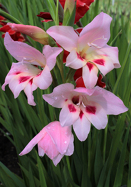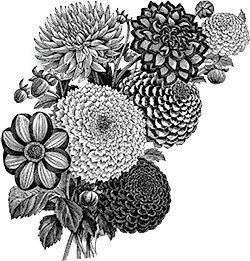|
Order these spring-planted bulbs NOW for shipping next spring. |
||

‘Elvira’, 1956
WHY GROW GLADS? They make luscious, long-lasting cut-flowers. They add dramatic spikes of color to the garden. And they multiply and store so easily (but only if you feel like it!), you’ll soon have many more. GLADIOLUS HISTORY — The first hybrid glads appeared in 1837, and Victorian gardeners — including Monet and Gertrude Jekyll — loved them. Unfortunately, virtually no glads from the 1800s survive today, and even glads from the 1940s are hard to find. TIPS FOR SUCCESS — Whether you call them gladiolas, gladioli, or gladiolus, glads are easy to grow, doing best in full sun and well-drained soil. Learn more here. |
||
|
Even Rarer Gladiolus — Every year we get a handful of spectacular bulbs that are so rare we offer them Web-Only. For an alert the moment they go on sale, subscribe to our free, monthly email newsletter.
|
||
|
||
|
||
|
||
|
||
|
||
|
||
|
WHY GROW GLADS? They make luscious, long-lasting cut-flowers. They add dramatic spikes of color to the garden. And they multiply and store so easily (if you feel like it; it’s NOT a moral imperative!), you’ll soon have many more. SMALL IS BEAUTIFUL — More and more gardeners today are rediscovering the charms of species and small-flowered glads. In 2006, the Brooklyn Botanic Garden asked Scott to extol his favorites in an article titled “Glads for Glad-Haters.” GLADIOLUS HISTORY — The first hybrid glads appeared in 1837, and Victorian gardeners — including Monet and Gertrude Jekyll — loved them. Unfortunately, virtually no glads from the 1800s survive today, and even glads from the 1930s are very hard to find. GLADIOLUS ARCHIVES — For customer tips and raves, the stories behind the bulbs, links and books, history, news, and more, see our Gladiolus Newsletter Archives. TIPS FOR SUCCESS — Glads are easy to grow, doing best in full sun and well-drained soil. They’re most often grown as annuals, but they’re perennial in zones 8 and warmer — and often return in zones 7, 6, and even 5, according to many of our customers. See our complete planting and care info here and learn more about overwintering glads in the garden here. THRIPS are one of the few pests that bother glads. They’re almost invisible but they can be devastating. Learn more. |

|
FALL
|
· |
SPRING
|
· |
SUMMER
|
· |
LEARN MORE
|
· |
ORDERING
|

|


















